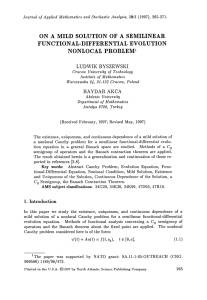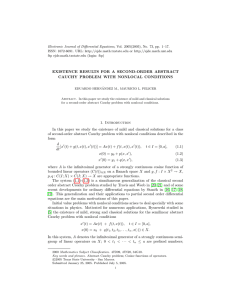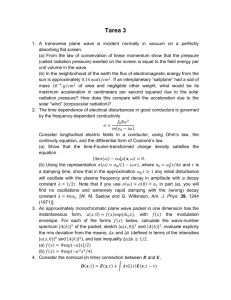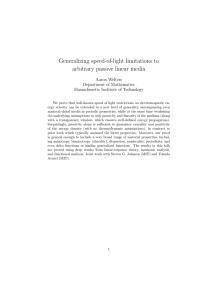Electronic Journal of Differential Equations, Vol. 2003(2003), No. 51, pp.... ISSN: 1072-6691. URL: or
advertisement
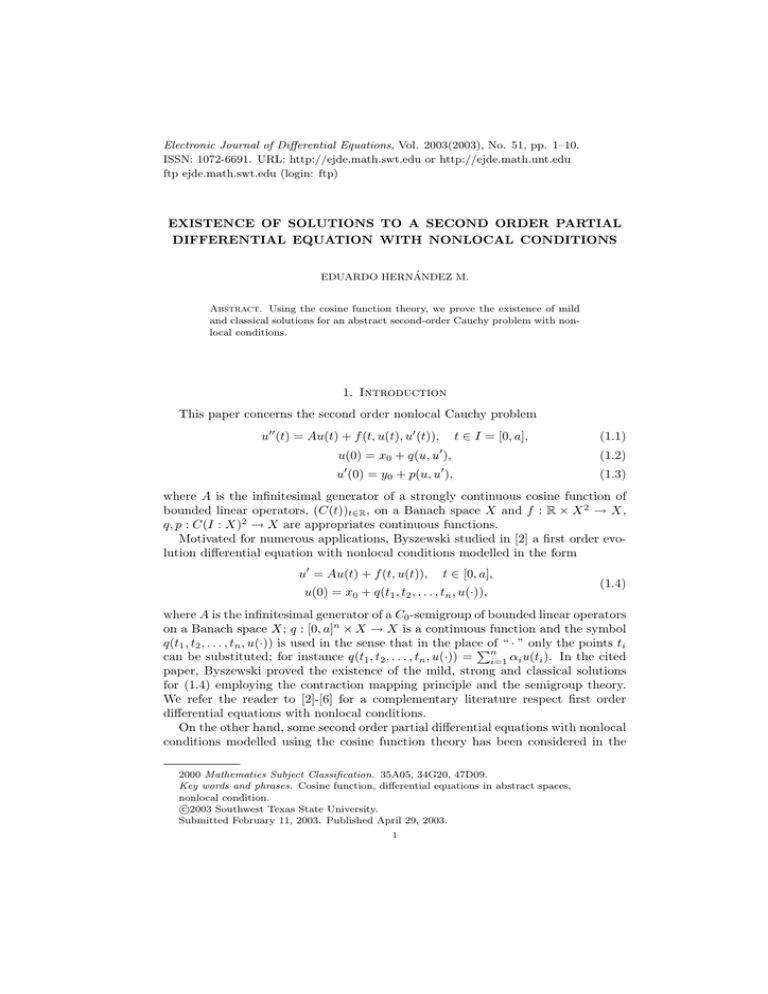
Electronic Journal of Differential Equations, Vol. 2003(2003), No. 51, pp. 1–10.
ISSN: 1072-6691. URL: http://ejde.math.swt.edu or http://ejde.math.unt.edu
ftp ejde.math.swt.edu (login: ftp)
EXISTENCE OF SOLUTIONS TO A SECOND ORDER PARTIAL
DIFFERENTIAL EQUATION WITH NONLOCAL CONDITIONS
EDUARDO HERNÁNDEZ M.
Abstract. Using the cosine function theory, we prove the existence of mild
and classical solutions for an abstract second-order Cauchy problem with nonlocal conditions.
1. Introduction
This paper concerns the second order nonlocal Cauchy problem
u00 (t) = Au(t) + f (t, u(t), u0 (t)),
t ∈ I = [0, a],
(1.2)
0
(1.3)
u(0) = x0 + q(u, u ),
0
(1.1)
0
u (0) = y0 + p(u, u ),
where A is the infinitesimal generator of a strongly continuous cosine function of
bounded linear operators, (C(t))t∈R , on a Banach space X and f : R × X 2 → X,
q, p : C(I : X)2 → X are appropriates continuous functions.
Motivated for numerous applications, Byszewski studied in [2] a first order evolution differential equation with nonlocal conditions modelled in the form
u0 = Au(t) + f (t, u(t)),
t ∈ [0, a],
u(0) = x0 + q(t1 , t2 , . . . , tn , u(·)),
(1.4)
where A is the infinitesimal generator of a C0 -semigroup of bounded linear operators
on a Banach space X; q : [0, a]n × X → X is a continuous function and the symbol
q(t1 , t2 , . . . , tn , u(·)) is used in the sense that in the placePof “ · ” only the points ti
n
can be substituted; for instance q(t1 , t2 , . . . , tn , u(·)) = i=1 αi u(ti ). In the cited
paper, Byszewski proved the existence of the mild, strong and classical solutions
for (1.4) employing the contraction mapping principle and the semigroup theory.
We refer the reader to [2]-[6] for a complementary literature respect first order
differential equations with nonlocal conditions.
On the other hand, some second order partial differential equations with nonlocal
conditions modelled using the cosine function theory has been considered in the
2000 Mathematics Subject Classification. 35A05, 34G20, 47D09.
Key words and phrases. Cosine function, differential equations in abstract spaces,
nonlocal condition.
c
2003
Southwest Texas State University.
Submitted February 11, 2003. Published April 29, 2003.
1
2
EDUARDO HERNÁNDEZ M.
EJDE–2003/51
literature, see for example [1, 13, 14]. In general the nonlocal conditions considered
in these works are described in the form
x(0) = g(x) + x0 ,
x0 (0) = η,
where g : C(I : X) → X is appropriate and η ∈ X is prefixed. It’s relevant
to observe that the problems studied in these papers do not consider “partial”
evolution equations, since the authors proved their results under the assumption
that the cosine function (C(t))t∈R , generated by A, is such that C(t) is compact
for every t > 0, which imply that dim(X) < ∞, see Travis and Weeb [15, pp. 557],
for details.
Our goal in this work is establish the existence of mild and classical solutions for
the abstract nonlocal Cauchy problem (1.1)-(1.3) using the cosine function theory
and the contraction mapping principle. The abstract results in this work are applicable to “partial” second order differential equations with nonlocal conditions, see
the examples in Section 3.
In this paper henceforth, C(·) = (C(t))t∈R is a strongly continuous cosine function of bounded linear operators on a Banach space X with infinitesimal generator
A. We refer the reader to [9, 15, 16] for the necessary concepts about cosine functions. Next, we only mention a few results and notations needed to establish our
results. We denote by S(t) the sine function associated with C(t) which is defined
by
Z t
S(t)x :=
C(s)xds, x ∈ X, t ∈ R.
0
For a closed operator B : D(B) ⊂ X → X we denote by [D(B)] the space D(B)
endowed with the graph norm k · kB . In particular, [D(A)] is the space
D(A) = {x ∈ X : C(t)x is twice continuously differentiable},
endowed with the norm kxkA = kxk + kAxk, x ∈ D(A). Moreover, in this work the
notation E stands for the space formed by the vectors x ∈ X for which the function
C(·)x is of class C 1 . We know from Kisiński [11], that E endowed with the norm
kxk1 = kxk + sup kAS(t)xk,
x ∈ E,
0≤t≤a
C(t) S(t)
is a Banach space. The operator valued function G(t) =
is a strongly
AS(t) C(t)
continuous group
bounded linear operators on the space E × X generated by the
of 0 I
operator A =
defined on D(A)×E. From this it follows that AS(t) : E → X
A 0
is a bounded operator and that AS(t)x → 0, as t → 0, for each x ∈ E. Furthermore,
Rt
if x : [0, ∞) → X is a locally integrable, then y(t) = 0 S(t − s)x(s)ds defines an
E-valued continuous function, which is a consequence of the fact that
"R
#
Z t
t
0
S(t
−
s)x(s)
ds
G(t − s)
ds = R 0t
x(s)
C(t − s)x(s) ds
0
0
defines an E × X-valued continuous function.
The existence of solutions of the second order abstract Cauchy problem
x00 (t) = Ax(t) + h(t),
x(0) = x0 ,
0
t ∈ [0, a],
x (0) = x1 ,
(1.5)
(1.6)
EJDE–2003/51
EXISTENCE OF SOLUTIONS
3
where h : [0, a] → X is an integrable function, has been discussed in [15]. Similarly,
the existence of solutions of the semilinear second order abstract Cauchy problem
has been treated in [16]. We only mention here that the function x(·) given by
Z t
x(t) = C(t)x0 + S(t)x1 +
S(t − s)h(s) ds, t ∈ [0, a],
(1.7)
0
is called a mild solution of (1.5)-(1.6) and that when x0 ∈ E, x(·) is continuously
differentiable and
Z t
x0 (t) = AS(t)x0 + C(t)x1 +
C(t − s)h(s) ds.
(1.8)
0
Regularity of mild solutions of problem (1.5)-(1.6) was treated by Travis and Weeb
in [16], by Bochenek in [7] and recently by Henriquez and Vasquez in [10].
This work contains three sections. In Section 2 we discuss existence of mild and
classical solution for some second order abstract Cauchy problem with nonlocal
conditions. In general the results are obtained using the contraction mapping principle and the ideas in [7], [10] and [16]. In the section 3, the “wave” equation with
nonlocal conditions is studied.
The terminologies and notations are those generally used in functional analysis.
In particular, if (Z, k·kZ ) and (Y, k·kY ) are Banach spaces, we indicate by L(Z : Y )
the Banach space of the bounded linear operators of Z in Y and we abbreviate this
notation to L(Z) whenever Z = Y . Br (x : Z) denotes the closed ball with center
at x and radius r > 0 in the space (Z, k · kZ ). Additionally, for a bounded function
ξ : [0, a] → Z and 0 ≤ t ≤ a we will employ the notation ξZ, t for
ξZ, t = sup{kξ(s)kZ : s ∈ [0, t]},
(1.9)
and we will write simply ξt when no confusion arises. Finally, we remark that the
prefix R is used to indicate the image of a map.
2. Existence Results
In this section we discuss the existence of mild and classical solutions for some
abstract second order partial differential equations with nonlocal conditions. Along
of this section, N ≥ 1 and Ñ are positive constants such that kC(t)k ≤ N and
kS(t)k ≤ Ñ for every t ∈ I. At first, we study the nonlocal Cauchy problem
u00 (t) = Au(t) + f (t, u(t)),
u(0) = x0 + q(u),
0
u (0) = y0 + p(u).
t ∈ I,
(2.1)
(2.2)
(2.3)
where f : R × X → X and q, p : C(I : X) → X are appropriates continuous
functions.
By comparison with Travis [16], we introduce the followings definitions.
Definition 2.1. A function u ∈ C(I : X) is a mild solution of the nonlocal Cauchy
problem (2.1)-(2.3) if condition (2.2) is verified and
Z t
u(t) = C(t)(x0 + q(u)) + S(t)(y0 + p(u)) +
S(t − s)f (s, u(s))ds, t ∈ I. (2.4)
0
Definition 2.2. A function u(·) ∈ C 2 (I : X) is a classical solution of the nonlocal Cauchy problem (2.1)-(2.3), if u(·) is solution of the equation (2.1) and the
conditions (2.2)-(2.3) are verified.
4
EDUARDO HERNÁNDEZ M.
EJDE–2003/51
Now, we establish our first result.
Theorem 2.3. Let x0 , y0 ∈ X and assume that there exist positive constants
lf , lp , lq such that
kf (t, x) − f (t, y)k ≤ lf kx − yk,
x, y ∈ X,
kq(u) − q(v)k ≤ lq ku − vka ,
u, v ∈ C(I : X),
kp(u) − p(v)k ≤ lp ku − vka ,
u, v ∈ C(I : X).
If θ = N lq + Ñ lp + Ñ lf a < 1, then there exist a unique mild solution of (2.1)-(2.3).
Proof. On the space Y = C(I : X) endowed with the sup norm, we define the
mapping Φ : Y → Y , where
Z t
Φu(t) = C(t)(x0 + q(u)) + S(t)(y0 + p(u)) +
S(t − s)f (s, u(s))ds.
0
It is easy to see that Φ is well defined and with values in Y . Moreover, for
(u, w), (v, z) ∈ Y we get
Z t
kΦu(t) − Φv(t)k ≤ N lq ku − vka + Ñ lp ku − vka + Ñ lf
ku − vkθ dθ,
0
≤ N lq + Ñ lp + aÑ lf ku − vka ,
which imply that Φ is a contraction on Y . Thus, there exist a unique mild solution
of (2.1)-(2.3). The proof is complete.
Remark 2.4. In relation with the next result, we remark that a Banach space Y
has the Radom Nikodym property, (abbreviated RNP), respect to a finite measure
space (Ω, Σ, µ); if for each continuous vector measure
R G : Σ → Y of bounded
variation, there exists g ∈ L1 (µ, Y ) such that G(E) = E gdµ for every E ∈ Σ. We
refer to [8] for additional details respect of this matter.
Remark 2.5. In Theorem 2.6, below, A∗ : D(A∗ ) → X ∗ is the adjoint operator of
A which is well defined since D(A) is dense in X.
Theorem 2.6. Let the assumptions of Theorem 2.3 be satisfied. If x0 +Rq ⊂ D(A),
y0 + Rp ⊂ E and any of the followings conditions is verified,
(a) The adjoint operator A∗ : D(A∗ ) → X ∗ is such that D(A∗ ) = X ∗ ;
(b) The space X has the RNP property;
(c) f (·) is continuously differentiable;
then the unique mild solution, u(·), of (2.1)-(2.3) is a classical solution.
Proof. From the preliminaries we know that u(·) is continuously differentiable and
so that the function t → f (t, u(t)) is Lipschitz on I. Let y(·) ∈ C(I : X) be the
unique mild solution of
x00 (t) = Ax(t) + f (t, u(t)),
x(0) = x0 + q(u),
0
x (0) = y0 + p(u).
t ∈ I,
(2.5)
(2.6)
(2.7)
If (a) holds, it follows from [7, Theorem 1] that y(·) is a classical solution. On the
other hand, if X has the RN P , then s → f (s, u(s)) ∈ W 1,1 (I : X) which, from
[10, Theorem 3.1], implies that y(·) is a classical solution of (2.5)-(2.7). When (c)
is verified, from [16, Proposition 2.4] it follows that y(·) is also a classical solution.
EJDE–2003/51
EXISTENCE OF SOLUTIONS
5
Finally, from the uniqueness of solution of (2.5)-(2.7) we infer that u(·) = y(·)
and so that u(·) is a classical solution of (2.1)-(2.3).
Next, we study existence of solution for (1.1)-(1.3).
Definition 2.7. A function u ∈ C 1 (I : X) is a mild solution of the nonlocal Cauchy
problem (1.1)-(1.3) if the conditions (1.2)-(1.3) are verified and
Z t
0
0
u(t) = C(t)(x0 +q(u, u ))+S(t)(y0 +p(u, u ))+
S(t−s)f (s, u(s), u0 (s))ds, t ∈ I.
0
2
Definition 2.8. A function u(·) ∈ C (I : X) is a classical solution of the nonlocal
Cauchy problem (1.1)-(1.3), if u(·) is solution of (1.1) and the conditions (1.2), (1.3)
are satisfied.
Theorem 2.9. Let (x0 , y0 ) ∈ E × X and assume that the followings conditions
hold:
(a) f is continuous and there exist positive constants li , i = 1, 2 such that
kf (t, x1 , y1 ) − f (t, x2 , y2 )k ≤ lf1 kx1 − x2 k + lf2 ky1 − y2 k,
xi , yi ∈ X.
2
(b) The functions q(·), p(·) : C(I : X) → X are continuous, q(·) is E-valued
and there exist positive constants lpi , lqi , i = 1, 2 such that
kq(u, w) − q(v, z)k1 ≤ lq1 ku − vka + lq2 kw − zka ,
kp(u, w) − p(v, z)k ≤ lp1 ku − vka + lp2 kw − zka ,
for every u, v, w, z ∈ C(I : X).
Let Θ1 = maxi=1,2 {N lqi + Ñ (lpi + alfi )} and Θ2 = maxi=1,2 {lqi + N (lpi + alfi )}. If
Θ = Θ1 + Θ2 < 1, then there exist a unique mild solution of (1.1)-(1.3).
Proof. On the space Y = C(I : X)2 , equipped with the norm
k(u, v)k = kuka + kvka ,
we define the map Φ : Y → Y , where Φ(u, v) = (Φ1 (u, v), Φ2 (u, v)) and
Z t
Φ1 (u, v)(t) = C(t)(x0 + q(u, v)) + S(t)(y0 + p(u, v)) +
S(t − s)f (s, u(s), v(s))ds,
0
Z
t
C(t − s)f (s, u(s), v(s))ds.
Φ2 (u, v)(t) = AS(t)(x0 + q(u, v)) + C(t)(y0 + p(u, v)) +
0
It follows from the assumptions that each Φi is well defined and with values in
C(I : X). Moreover, for (u, v), (w, z) ∈ Y we get
kΦ1 (u, v)−Φ1 (w, z)ka ≤ N lq1 + Ñ (lp1 +alf1 ) ku−wka + N lq2 + Ñ (lp2 +alf2 ) kv −zka ,
and so that
kΦ1 (u, v) − Φ1 (w, z)ka ≤ max {N lqi + Ñ (lpi + alfi )}k(u, v) − (w, z)ka .
i=1,2
(2.8)
On the other hand, from the preliminaries and condition (b) we get
kΦ2 (u, v) − Φ2 (w, z)ka
≤ kq(u, v) − q(w, z)k1 + N lp1 + alf1 ku − wka + N lp2 + alf2 kv − zka ,
and hence
kΦ2 (u, v) − Φ2 (w, z)ka ≤ max { lqi + N (lpi + alfi ) }k(u, v) − (w, z)ka .
i=1,2
(2.9)
6
EDUARDO HERNÁNDEZ M.
EJDE–2003/51
Finally, from (2.8) and (2.9), it follows that
kΦ(u, v) − Φ(w, z)ka ≤ Θk(u, v) − (w, z)ka ,
which imply that Φ is a contraction. Thus, there exists a unique mild solution of
(1.1)-(1.3). The proof is complete.
To prove the next theorem we need the followings result.
Corollary 2.10. Assume that the assumptions in Theorem 2.9 are verified and let
u(·) be the mild solution of (1.1)-(1.3). Suppose, furthermore, that there exists lf3
such that
kf (t, x, y) − f (s, x, y)k ≤ lf3 |t − s|,
t, s ∈ I,
x, y ∈ X.
If (x0 + q(u, u0 ), y0 + p(u, u0 )) ∈ D(A) × E, then u0 (·) is Lipschitz on I.
Proof. Let t ∈ I and h ∈ R with t + h ∈ I. Using that s → u(s) is Lipschitz on I
and that, for t ∈ I,
Z t
0
0
0
u (t) = S(t)A(x0 + q(u, u )) + C(t)(y0 + p(u, u )) +
C(t − s)f (s, u(s), u0 (s))ds,
0
we obtain
Z h
ku0 (t + h) − u0 (t)k ≤ C1 h +
kC(t + h − s)f (s, u(s), u0 (s))kds
0
Z t
1
+N
[ lf ku(s + h) − u(s)k + lf2 ku0 (s + h) − u0 (s)k + lf3 h ]ds
0
Z t
≤ C2 h + N lf2
ku0 (s + h) − u0 (s)kds,
0
where Ci , i = 1, 2, are constants independents of h and t ∈ I. The assertion is now
consequence of the Gronwall inequality.
In what follows, for the function j : I → X and h ∈ R we use the notation
j(t + h) − j(t)
.
h
Moreover, if j(·) : I × X → X is differentiable, we use the decomposition
∂h j(t) :=
(2.10)
j(t + s, y + y1 , w + w1 ) − j(t, y, w)
= (D1 j(t, y, w), D2 j(t, y, w), D3 j(t, y, w))(s, y1 , w1 )
+ k(s, y1 , w1 )k
I×X 2
(2.11)
R(j(t, y, w), s, y1 , w1 ),
where kR(j(t, y, w), s, y1 , w1 )k → 0 when k(s, x1 , y1 )kI×X 2 = |s| + kx1 k + ky1 k → 0.
Theorem 2.11. Let assumptions in Corollary 2.10 be satisfied and u(·) be the mild
solution of (1.1)-(1.3). If (x0 +q(u), y0 +p(u)) ∈ D(A)×E and any of the following
conditions hold:
(a) The adjoint operator A∗ : D(A∗ ) → X ∗ is such that D(A∗ ) = X;
(b) The space X has the RNP property;
(c) f is continuously differentiable,
then u(·) is a classical solution of (1.1)-(1.3).
EJDE–2003/51
EXISTENCE OF SOLUTIONS
7
Proof. Firstly we remark that from Corollary 2.10 the function t → f (s, u(t), u0 (t))
is Lipschitz on I. When (a) or (b) are verified, the assertion follows using the steps
in the proof of Theorem 2.6. Assume that condition (c) holds and let v(·) ∈ C(I : X)
be the unique solution of the integral problem
v(t) = C(t)A(x0 + q(u, u0 )) + AS(t)(y0 + p(u, u0 )) + f (0, u(0), u0 (0))
Z t
Z t
+
C(t − s)D1 f (w(s))ds +
C(t − s)D2 f (w(s))(u0 (s))ds
0
0
Z t
+
C(t − s)D3 f (w(s))(v(s))ds, t ∈ I,
(2.12)
0
v(0) = A(x0 + q(u, u0 )) + f (0, u(0), u0 (0)),
(2.13)
where ξ(t) = (t, u(t), u0 (t)). The existence and uniqueness of a solution of (2.12)(2.13) follows from the contraction mapping principle; we omit additional details.
Next, we prove that u00 (·) = v(·) on I. Let t ∈ I and h ∈ R with t + h ∈ I. Since,
for t ∈ I,
Z t
u0 (t) = AS(t)(x0 + q(u, u0 )) + C(t)(y0 + p(u, u0 )) +
C(t − s)f (s, u(s), u0 (s))ds,
0
(2.14)
from (2.12), we obatin
k∂h u0 (t) − v(t)k
Z
1 h
kC(t + h − s)kkf (s, u(s), u0 (s)) − f (0, u(0), u0 (0))kds
≤ γ1 (h) +
h 0
Z t
+N
k∂h f (ξ(s)) − D1 f (ξ(s)) − D2 f (ξ(s))(u0 (s)) − D3 f (ξ(s))(v(s))kds
0
Z t
≤ γ2 (h) + N
kD3 f (ξ(s))kL(X) k∂h u0 (s) − v(s)kds
0
Z t
+N
k(1, ∂h u(s), ∂h u0 (s))kI×X 2 kR(f (ξ(s)), h, h∂h u(s), h∂h u0 (s))kds,
0
where γi (h) → 0 as h → 0. It follows, from the Gronwall-Bellman inequality and
Corollary 2.10, that ∂h u0 (·) → v(·) when h → 0 and so that u00 (·) = v(·) on I.
From these remarks and Proposition 2.4 in [16], we infer that the mild solution,
y(·), of the abstract Cauchy problem
x00 (t) = Ax(t) + f (t, u(t), u0 (t)),
t ∈ I,
0
x(0) = x0 + q(u, u ),
0
(2.15)
0
x (0) = y0 + p(u, u ),
is a classical solution, which from the uniqueness solution of (2.15) permit conclude
that y(·) = u(·) and that u(·) is a classical solution of (1.1)-(1.3). The proof is
complete.
3. The wave equation with nonlocal conditions
In this section we illustrate some of the results of this work with the wave equation. On the space X = L2 ([0, π]) we consider the operator Af (ξ) = f 00 (ξ) with
domain D(A) = {f (·) ∈ H 2 (0, π) : f (0) = f (π) = 0}. It’s well known that A
8
EDUARDO HERNÁNDEZ M.
EJDE–2003/51
is the generator of strongly continuous cosine function (C(t))t∈R on X. Furthermore, A has discrete spectrum, the eigenvalues are −n2 , n ∈ N, with corresponding
normalized eigenvectors zn (ξ) := ( π2 )1/2 sin(nξ) and the following conditions hold :
(a) {zn : n ∈ N} is an orthonormal
P∞ basis of X.
(b) If ϕ ∈ D(A) then A ϕ =P
− n=1 n2 < ϕ, zn > zn .
∞
(c) For ϕ ∈ X, C(t)ϕ =
n=1 cos(nt) < ϕ, zn > zn . Moreover, from these
P∞
expression, it follows that S(t)ϕ = n=1 sin(nt)
< ϕ, zn > zn , that S(t)
n
is compact for every t > 0 and that kC(t)k ≤ 1 and kS(t)k ≤ 1 for every
t ∈ [0, π].
(d) If G denotes the group of translations on X defined by G(t)x(ξ) = x̃(ξ + t),
where x̃ is the extension of x with period 2π, then C(t) = 12 (G(t) + G(−t)).
Hence it follows, see [9], that A = B 2 , where B is the infinitesimal generator
of the group G and that E = {x ∈ H 1 (0, π) : x(0) = x(π) = 0}.
Now, we consider the boundary-value problem with nonlocal conditions
∂ 2 w(t, ξ)
∂ 2 w(t, ξ)
=
+ F (t, ξ, w(t, ξ)), t ∈ I = [0, π],
2
∂t
∂ξ 2
w(t, 0) = w(t, π) = 0, t ∈ I,
w(0, ξ) = x0 (ξ) +
n
X
ξ ∈ I,
αi w(ti , ξ),
(3.1)
(3.2)
(3.3)
i=1
k
X
∂w(0, ξ)
= y0 (ξ) +
βi w(si , ξ),
∂t
i=1
ξ ∈ I,
(3.4)
where x0 , y0 ∈ X; F : I 2 × R → R is continuous and 0 < ti , sj < π, αi , βj are
prefixed numbers. Under the previous conditions, the nonlocal differential problem
(3.1)-(3.4) can be modelled as the abstract nonlocal Cauchy problem
u00 (t) = Au(t) + f (t, u(t)),
t ∈ I,
(3.5)
u(0) = x0 + q(u),
(3.6)
0
u (0) = y0 + p(u),
(3.7)
where f (t, x)(ξ) = F (t, ξ, x(ξ)), x ∈ X, and p, q : C(I : X) → X are defined by
q(u)(ξ) =
n
X
αi u(ti , ξ),
p(u)(ξ) =
i=1
k
X
βi u(si , ξ),
u ∈ C(I : X).
i=1
Proposition 3.1. Assume that the previous conditions are verified and that there
exists a function η(·) ∈ L1 (I : L∞ (I : R)) such that
|F (t, ξ, x1 ) − F (t, ξ, x2 )| ≤ η(t, ξ)|x1 − x2 |,
t, ξ ∈ I, xi ∈ R.
If
Θ=
n
X
i=1
|αi | +
k
X
i=1
Z
|βi | +
π
η(s, ·)π ds < 1,
0
then there exists a unique mild solution, u(·), of (3.5)-(3.7). If in addition x0 +
Pn
Pk
i=1 αi u(ti ) ∈ D(A) and y0 +
i=1 βi u(si ) ∈ E, then u(·) is a classical solution.
For the proof of this proposition: the existence follows from Theorem 2.3, and the
regularity assertion is consequence of Theorem 2.6 since X has the RNP property.
EJDE–2003/51
EXISTENCE OF SOLUTIONS
9
To complete this section we consider the nonlocal Cauchy problem
∂ 2 w(t, ξ)
∂ 2 w(t, ξ)
∂w(t, ξ)
=
+ F (t, ξ, w(t, ξ),
), t ∈ I,
∂t2
∂ξ 2
∂t
w(t, 0) = w(t, π) = 0, t ∈ I,
Z π
w(0, ξ) = x0 (ξ) +
Q(w(s, ·))(ξ)ds, ξ ∈ I,
0
Z π
∂w(0, ξ)
∂w(s, ·)
= y0 (ξ) +
P(
)(ξ)ds, ξ ∈ I,
∂t
∂s
0
(3.8)
(3.9)
(3.10)
(3.11)
where x0 , y0 ∈ X and P : X → X, Q : X → E are Lipschitz continuous. We
refer the reader to [12] for examples of operators with these properties. Under the
previous conditions, problem (3.8)-(3.11) can be modelled as the abstract nonlocal
Cauchy problem
u00 (t) = Au(t) + f (t, u(t), u0 (t)),
t ∈ I,
(3.12)
0
(3.13)
0
(3.14)
u(0) = x0 + q(u, u ),
0
u (0) = y0 + p(u, u ),
where the substituting operators f : I × X → X and p, q : C(I : X)2 → X are
defined by f (t, x)(ξ) = F (ξ, t, x(ξ)) and
Z π
Z π
p(u, v) =
P (v(s))(ξ)ds and q(u, v) =
Q(u(s))(ξ)ds, u, v ∈ C(I : X).
0
0
Proposition 3.2. Assume that the followings conditions are satisfied.
(a) There exist a continuous function η : I 3 → R such that
|F (t, ξ, x1 , x2 ) − F (s, ξ, y1 , y2 )| ≤ η(t, s, ξ)( |t − s| +
2
X
|xi − yi |)
i=1
for every t, s, ξ ∈ I, xi , yi ∈ R.
(b) There exist constants LP , LQ such that
kP (x) − P (y)k ≤ LP kx − yk,
x, y ∈ X,
kQ(x) − Q(y)k1 ≤ LQ kx − yk, x, y ∈ X.
Rπ
If Θ = 2(LP + LQ )π + 2 0 η(s, s, ·)π ds < 1, then there exist a unique mild solution,
u(·), of (3.12)-(3.14). If (x0 + q(u, u0 ), y0 + p(u, u0 )) ∈ D(A) × E, then u(·) is a
classical solution.
References
[1] M. Benchohra, and S. K. Ntouyas, Existence of mild solutions of second order initial value
problems for differential inclusions with nonlocal conditions. Atti Sem. Mat. Fis. Univ. Modena 49. 2(2001), 351-361.
[2] L. Byszewski, Theorems about the existence and uniqueness of solutions of a semilinear
evolution nonlocal Cauchy problem. J. Math. Anal. Appl. 162 2 (1991), 494-505 .
[3] L. Byszewski, H. Akca, Existence of solutions of a semilinear functional-differential evolution
nonlocal problem, Nonlinear Anal., 34 1 (1998), 65-72.
[4] L. Byszewski, V. Lakshmikantham, Theorem about the existence and uniqueness of a solution
of a nonlocal abstract Cauchy problem in a Banach space. Appl. Anal., 40 1 (1991), 11-19.
[5] L. Byszewski, H. Akca, On a mild solution of a semilinear functional-differential evolution
nonlocal problem. J. Appl. Math. Stochastic Anal., 10 3 (1997), 265-271.
10
EDUARDO HERNÁNDEZ M.
EJDE–2003/51
[6] Ludwik Byszewski, Application of properties of the right-hand sides of evolution equations to
an investigation of nonlocal evolution problems. Nonlinear Anal. 33 (1998), no. 5, 413–426.
[7] J. Bochenek, An abstract nonlinear second order differential equation. Ann. Polon. Math. 54
(1991), no. 2, 155–166.
[8] J. Diestel and J. J. Uhl, Vector measures. Mathematical Surveys, No. 15. American Mathematical Society, Providence, R.I., 1977.
[9] H. O. Fattorini, Second Order Linear Differential Equations in Banach Spaces, NorthHolland Mathematics Studies, Vol. 108, North-Holland, Amsterdam, 1985.
[10] Hernndez R. Henrquez, Carlos H. Vsquez, Differentiabilty of solutions of the second order
abstract Cauchy problem. Semigroup Forum 64 3 (2002), 472–488.
[11] J. Kisyński, On second order Cauchy’s problem in a Banach space, Bull. Acad. Polon. Sci.
Ser. Sci. Math. Astronm. Phys., 18 (1970) 371-374.
[12] R. H. Martin, Nonlinear Operators and Differential Equations in Banach Spaces, Robert E.
Krieger Publ. Co., Florida, 1987.
[13] S. K. Ntouyas; P. Ch. Tsamatos, Global existence for second order semilinear ordinary and
delay integrodifferential equations with nonlocal conditions, Appl. Anal., 67 3-4 (1997), 245257.
[14] S. K. Ntouyas, Global existence results for certain second order delay integrodifferential equations with nonlocal conditions, Dynam. Systems Appl., 7 3 (1998), 415-425.
[15] C. C. Travis, G. F. Webb, Compactness, regularity, and uniform continuity properties of
strongly continuous cosine families, Houston J. Math. 3 (4) (1977), 555-567.
[16] C. C. Travis, G. F. Webb, Cosine families and abstract nonlinear second order differential
equations. Acta Math. Acad. Sci. Hungaricae, 32 (1978), 76-96.
Departamento de Matemática, Instituto de Ciências Matemáticas de São Carlos,
Universidade de São Paulo, Caixa Postal 668, 13560-970 São Carlos, SP. Brazil
E-mail address: lalohm@icmc.sc.usp.br

